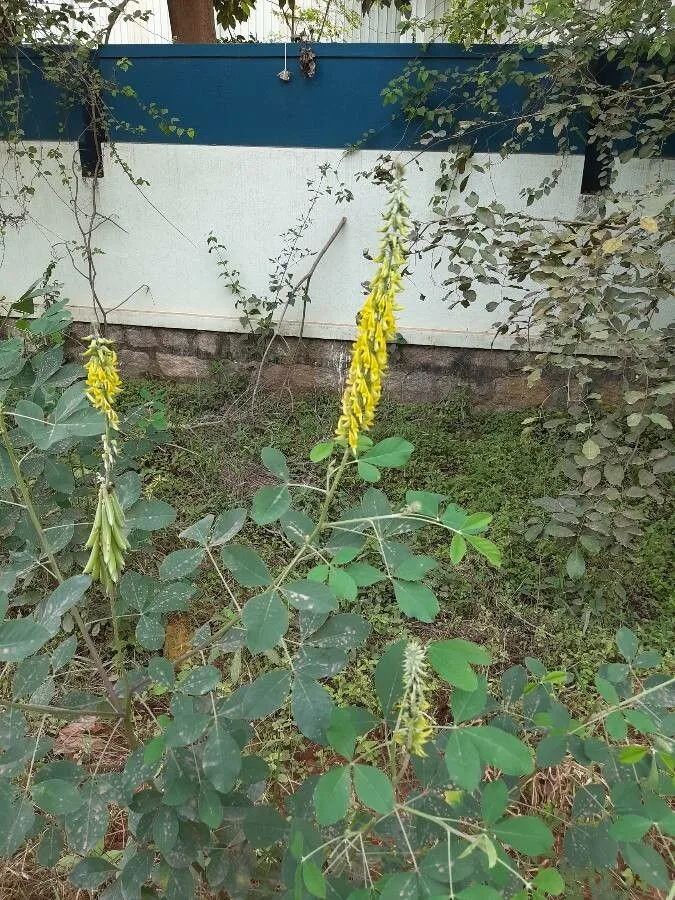
Author: Aiton
Bibliography: Hort. Kew. 3: 20 (1789)
Year: 1789
Status: accepted
Rank: species
Genus: Crotalaria
Vegetable: Unknown
Observations: Trop. & Subtrop. Old World
The Moreton Island rattlepod, scientifically known as Crotalaria pallida, is an interesting and notable member of the Fabaceae family. First documented by Aiton in 1789, the plant’s origin and distribution span across tropical and subtropical regions of the Old World, hinting at a rich history and adaptation to various climatic conditions.
With its vibrant yellow flowers and characteristic rattling seed pods, the Moreton Island rattlepod stands out in its native habitats. The seed pods, when shaken, produce a distinctive sound that is the inspiration behind its common name. These acoustic properties have made the plant a subject of curiosity and interest among both botanists and plant enthusiasts.
Crotalaria pallida thrives in warm, sunny climates and often populates open, disturbed areas, making it a frequent sight in places where land has been cleared. Its ability to fix nitrogen helps it enrich the soil, playing an important ecological role in fostering healthier plant communities. Additionally, it can often be recognized by its erect, branching stems and trifoliate leaves which are indicative characteristics of many members of the Fabaceae family.
Beyond its ecological importance, the Moreton Island rattlepod has also been studied for its potential medicinal properties. Historically, various parts of the plant have been used in traditional medicine across different cultures within its growing range. This underscores the plant’s multifaceted utility beyond its environmental contributions.
In summary, Crotalaria pallida, known commonly as the Moreton Island rattlepod, is a versatile and ecologically significant plant with a wide distribution across tropical and subtropical regions. Its distinct features, ecological roles, and historical medicinal uses make it a noteworthy species within the Fabaceae family.
Eng: moreton island rattlepod, smooth rattlebox, salts rattlebox, smooth crotalaria, streaked rattlepod, striped crotalaria
Fra: crotalaire mucronée
Ita: crotalaria striata
En: Moreton Island rattlepod, Smooth crotalaria, Smooth rattlebox, Salts rattlebox, Streaked rattlepod, Striped crotalaria, Broad-leaved rattlepod, Crotalaria, Ding Ding, Money Bush, Pine Kotalelia
Zh: Zhu shi dou
Fr: Crotalaire mucronée, Cascavelle Trois Feuilles
It: Crotalaria striata
Taken Sep 19, 2019 by Vitalis Keifer (cc-by-sa)
Taken Dec 12, 2021 by Naveen Reddy (cc-by-sa)
Taken Sep 9, 2021 by Naveen Reddy (cc-by-sa)
Taken Jul 25, 2021 by Zumbado Manuel (cc-by-sa)
Taken Jan 15, 2020 by Chee Keong Chan (cc-by-sa)
Taken Nov 19, 2019 by s vadivel (cc-by-sa)
Taken Jul 25, 2021 by Zumbado Manuel (cc-by-sa)
Taken Jul 1, 2022 by Trap Hers (cc-by-sa)
Taken Oct 14, 2021 by Herson (cc-by-sa)
Taken Jan 24, 2006 by Tela Botanica − Liliane ROUBAUDI (cc-by-sa)
Taken Sep 28, 2021 by ahmad qazi (cc-by-sa)
Taken Oct 19, 2019 by Diana (cc-by-sa)
Taken May 29, 2022 by Marcos Vinicius (cc-by-sa)
Taken Nov 19, 2019 by s vadivel (cc-by-sa)
Taken Oct 21, 2021 by Mobo Eko (cc-by-sa)
Taken Nov 26, 2022 by Prasanta Hembram (cc-by-sa)
Taken Oct 24, 2022 by Sudhanshu Kumar (cc-by-sa)
Taken Jan 5, 2020 by Rajendra Rajendra Choure (cc-by-sa)
Taken Jul 31, 2021 by Michael Finch (cc-by-sa)
Taken Jun 28, 2021 by pierre vernet (cc-by-sa)
© copyright of the Board of Trustees of the Royal Botanic Gardens, Kew.
© copyright of the Board of Trustees of the Royal Botanic Gardens, Kew.
© copyright of the Board of Trustees of the Royal Botanic Gardens, Kew.
Taken Apr 10, 2021 by Sébastien TRASBOT (cc-by-sa)
Taken Nov 26, 2022 by Prasanta Hembram (cc-by-sa)
Taken Sep 2, 2018 by Sharath Kathare (cc-by-sa)
Taken Nov 11, 2021 by Fadlan Solichin (cc-by-sa)
Taken Oct 14, 2021 by Herson (cc-by-sa)
Taken May 19, 2021 by Asim Kumar Mishra (cc-by-sa)
Taken Jun 2, 2020 by William William (cc-by-sa)
Taken Jun 13, 2020 by Reagan Vernon (cc-by-sa)
Family: Myrtaceae Author: (F.Muell.) K.D.Hill & L.A.S.Johnson Bibliography: Telopea 6: 402 (1995) Year: 1995 Status:…
Family: Rubiaceae Author: Pierre ex A.Froehner Bibliography: Notizbl. Bot. Gart. Berlin-Dahlem 1: 237 (1897) Year:…
Family: Sapindaceae Author: Koidz. Bibliography: J. Coll. Sci. Imp. Univ. Tokyo 32(1): 38 (1911) Year:…
Family: Asteraceae Author: A.Gray Bibliography: Pacif. Railr. Rep.: 107 (1857) Year: 1857 Status: accepted Rank:…
Family: Fabaceae Author: Medik. Bibliography: Vorles. Churpfälz. Phys.-Ökon. Ges. 2: 398 (1787) Year: 1787 Status:…
Family: Aspleniaceae Author: (Cav.) Alston Bibliography: Bull. Misc. Inform. Kew 1932: 309 (1932) Year: 1932…